Sea Plantain – Identification, Edibility, Distribution, Ecology, Recipes
Plantago marítima (var. marítima)
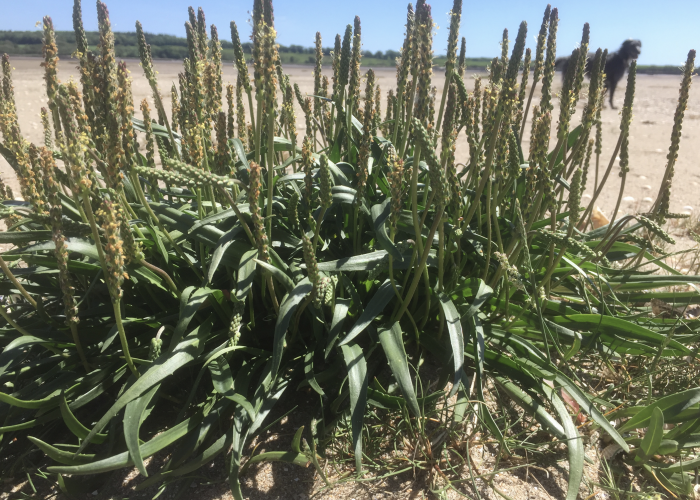
Sea Plantain – Plantago marítima
- Edibility –Leaves 4/5 – A superb, tender, salty succulent plant with a complex flavour: crunch, salinity, fresh green, some sweetness and mushroomy backnotes. Eat the green leaves, not the flowering stems, which are tough and flavourless. Leaves are good eating at most stages of growth, though can get a bit stringy with age, and depending on where they are growing. While the flower stalks, roots and seeds are all edible, they aren’t particularly worthwhile compared to the leaves. The immature flower heads (still green in the middle) are good source of roughage, but are less rewarding and flavoursome than those of ribwort plantain. The distinct and intriguing mushroomy flavour of sea plantain (and other members of the Plantago genus) is a gastronomic mystery that i’ve pondered for many years. While I can’t find any specific evidence relating to flavour, it is well documented that many Plantago species are saturated with endomycorhizal fungi (fungi whose mycelia permeates the cell walls of its hosts, as opposed to ectomycorhizal fungi, whose mycelia sheathe the roots of partner plants – see my webinar “Understanding Fungi” for a detailed exploration of this). It seems likely that their inundation with these beneficial fungal partners contributes to their fungal flavour. Sea plantain also contains sorbitol, a compound that offsets the challenges of salinity. Sorbitol is a sugar alcohol commonly found in many plants and fruits (including apples and blackberries). It contains one-third fewer calories than sugar and is 60 percent as sweet. It can have diuretic, laxative and purgative properties in large doses, but is generally good for us as part of a biodiverse diet – you’d need to feast heavily and regularly on sea plantain to get any digestive discomfort from it. When cooking with sea plantain (and other coastal succulents) you can reduce the seasoning you use as they bring a gentle salinity of their own.
- Identification – 3/5 – Long, pointed, succulent leaves (like very fat grass!), 10 – 30cm long, up to 1cm wide, V or U – shaped in cross section, sometimes (when mature) with sparse, small (easy to miss) points on the side of the blades. Close observation will reveal 3 – 5 feint longitudinal venis on the underside of leaves, though these aren’t nearly so pronounced as in ribwort or greater plantain. The flowers are small, greenish-brown with brown stamens, produced in a dense spike 0.5–10 cm long on top of a stem that can grow up to 20 cm tall.
- Similar species – There are no poisonous succulent coastal plants that look like sea plantain around the UK, but a few edible species could be confused for it. Sea arrowgrass (Triglochin maritima) often grows right beside sea plantain. It has thinner leaves that sheathe at the base, with flowers/seeds more widely dispersed along the flowering stems. It tastes of coriander, and comes with some minor health warnings – read all about it here. Bucksthorn plantain (Plantago coronopus – see photo below) has flattened rosettes of antler-shaped leaves and grows only from rocky coastal cracks, rarely growing as lushly as sea plantain. It has a similar flavour profile and can be used in similar ways. Ribwort plantain (Plantago lanceolata) is the inland cousin of sea plantain, very common in gardens and hedgerows, but often also doing very well in coastal grasslands, so there is some overlap of habitat. Distinguish ribwort plantain by its less succulent broader leaves with defined longitudinal ribs. If you have tasted ribwort plantain but were put off by its bitterness, try sea plantain – it is much more rewarding in my opinion.
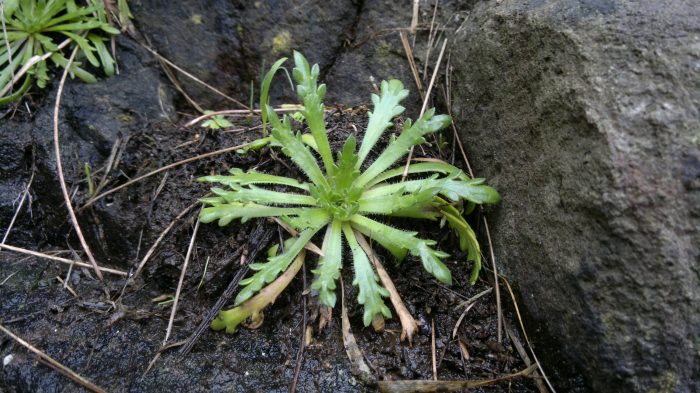
Stagshorn plantain can be used in similar ways, but tends to be smaller and more fiddly to harvest. It is slightly prettier though! 🙂
- Distribution – 4/5 – Common and prolific in almost all coastal habitats except pure sand/sand dune systems. Most abundant in salt marsh (merse) and muddy estuaries where it grows large, lush, and in big quantities, but also prolific in rocky shores (from shingle to boulders and cliffs), often growing from improbable cracks in coastal outcrops, where individual plants tend to be much more sparse, though still good eating. Grazing animals recognise its rich nourishment and it tends to be tightly cropped where sheep or deer graze by the coast – it can be much harder to harvest in NW Scotland where sheep and deer tend to heavily graze near the coast.
- Season – Year-round in sheltered locations, but generally April to October. Tastiest in May/June (pre-flowering) but does not become troublingly bitter after flowering like some other coastal plants.
- Habitat – Salt marsh (merse), edges of estuarine mud flats, at and above the mean tide line, and among sea defences on shingle shores, rocky outcrops, cliffs and coastal verges/grassland. Sea plantain can withstand regular immersion in the sea.
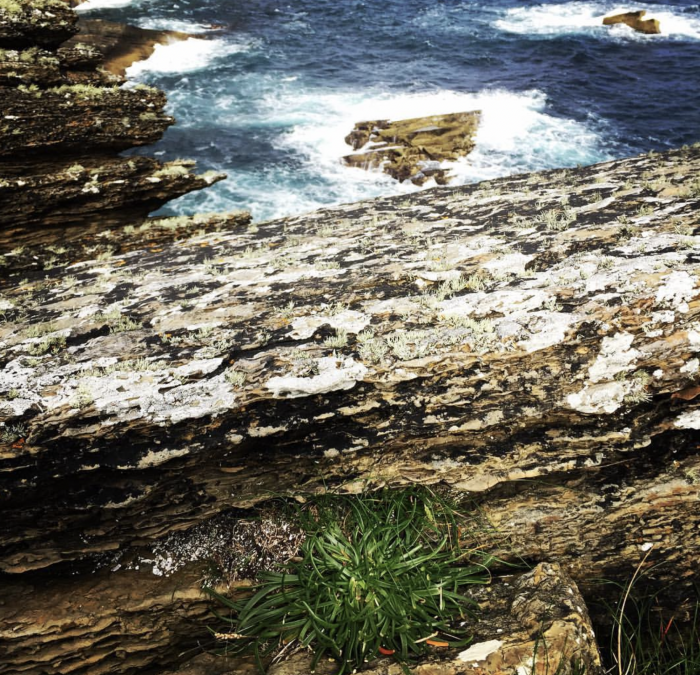
Sea plantain can grow in a variety of coastal habitats – including cracks that are just out of the wind on this Orkney cliff. Best to leave these ones as a few leaves may make all the difference to the plant in such precarious locations!
- Ecology – Sea plantain is a marvel of evolutionary adaptation. Its narrow leaves offer less resistance to water flow when its marine habitat floods and a deep taproot anchors it firmly against storms and shifting mud, while allowing it to gather precious drops of fresh water in an otherwise saline environment, and from unpromising looking cracks in rocks. Succulent leaves store water and their waxy outer helps prevent desiccation. Sea plantain can alter its cellular structure in response to increased salinity. On the salt marsh it can play a useful role in stabilising silt and mud, reducing erosion, allowing soil to form and other plants to colonise. While flowering sea plantain has been noted to attract insects, bees and butterflies, but it is monecious (bearing male and female organs on the same plant) and is wind pollinated.
- Sustainable harvesting – Generally abundant in most coastal habitats, but bear in mind that such abundance is important for stabilising marine habitats. Thin abundance, spreading your harvesting around, cutting clumps of leaves from bushy growths while taking care to leave flowering stems intact, then moving on to the next clump. Don’t clear out whole areas, and try to rotate your annual harvesting areas.
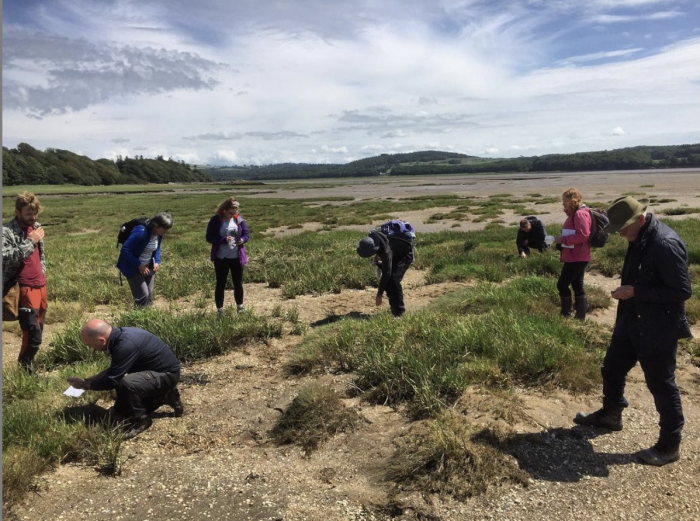
Foraging sea plantain on the salt marsh
Its a mystery to me why sea plantain rarely gets much more than support act billing in most foraging guides. I think it is one of the great coastal wild foods. Perhaps it doesn’t quite reach the sweet succulence of some of its more revered associates in the salt marsh – such as sea aster or marsh samphire, or the spiced quirkiness of sea arrowgrass or scurvy grass. But for my money, its rich crunchy salinity with intriguing back-notes of mushroom that hints at – but rarely develops – bitterness is delicious and unique.
On top of this, sea plantain is super-abundant and very easy to harvest in meal-sized quantities for much of the year.
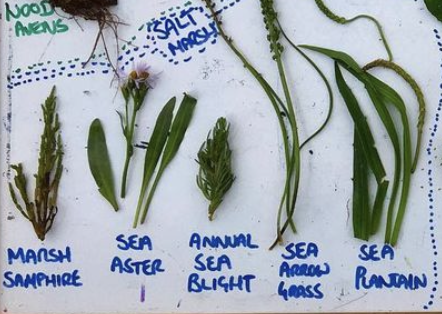
Sea plantain and other edible succulents of the salt marsh – you can just make out the small, sparse teeth that often occur on the mature leaves of sea plantain.
Cooking with Sea Plantain
Sea plantain’s crunchy succulence makes it great for stir frying – throw it in at the last minute.
Its long-thin leaves are perfect for rolling in the middle of wild sushi.
I chop it and cook it briefly in mushroom dishes, where it adds seasoning, spinachy richness and intriguing fungal banknotes that all fit in very well. It keeps its form well during more extended cooking and is great in risotto.
Its succulence also lends it to pickling as the leaves don’t break down in the acidic pickling solution like thinner inland greens. There is no need to heat or cook the sea plantain when pickling – simply wash the leaves thoroughly, place in a jar (a long, thin one if you want to leave them intact and make funky long, thin pickles!), and pour over a cold pickling mix – I recommend starting with the magic pickling proportions of a 3 : 2 : 1 mix – that is 3 parts water, 2 parts apple cider vinegar and 1 part sugar, plus a pinch of salt (remember, the sea plantain is quite saline already) – then tweaking to your preference. For a more detailed rundown of the pickling process, including some nice herbs you can add to mix, see this recipe (there is no need to pre-salt the sea plantain leaves as I do with the wild garlic buds). Sea arrowgrass seeds seem like an appropriate pickling spice, given their shared habitat! Alexander seeds are also a great coastal wild spice that work really well in pickling solutions.
I particularly like raw sea plantain chopped quite small and added to salads or coleslaw, and it works super-well in potato salads.
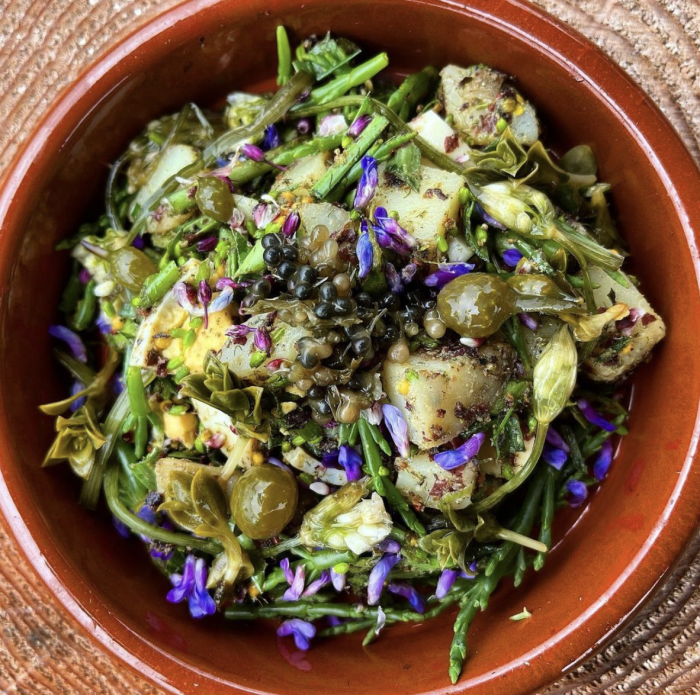
Galloway new potato & smoked egg salad with sea plantain. and some other coastal pleasures – marsh samphire, dulse, coriander grass seeds, pickled sandwort, egg wrack capers, crow garlic bulbils & tufted vetch flowers.
Related Posts:
- Coastal Wild Foods
- Sea arrowgrass – Identification, Edibility, Distribution, Recipes
- Sea aster – Identification, Edibility, Distribution, Recipes
- Marsh samphire – Identification, Edibility, Distribution, Recipes